Nassau County Courthouse Story Evokes Warm Memories
As a young lawyer then, I regret not paying close enough attention to the classic architectural details of my work space and the whole surrounding environs of that magnificent venue
May 01, 2018 at 12:27 PM
3 minute read

I was delighted to read the article about the laudable effort to gain landmark status for the historic and classical Nassau County Courthouse on Old Country Road in Mineola. The story evoked warm memories for me because I began my public service career there in 1963 as law secretary to Second Department Appellate Division Associate Justice Marcus G. Christ. I remained with him in that role until 1970, by which time he was presiding justice. The local residential chambers suite for Justice Christ (and my lovely adjacent office) were located at the southwest corner on the first floor of that county courthouse. The primary chambers were at 45 Monroe Place in Brooklyn.
As a young lawyer then, I regret not paying close enough attention to the classic architectural details of my work space and the whole surrounding environs of that magnificent venue. I also recall naively wondering why my Judge – the most senior jurist in the county – did not occupy the more spacious chambers suite located nearby. Supreme Court Trial Justice Mario Pittoni presided there and one day told me the story of how he came to have those chambers. My unassuming judge had deferred to him, though he was junior, because the senior judge simply thought that the trial justice needed the extra space for daily conferencing routines in working with the lawyers on trials.
Judge Christ was a very practical man and a very classy man, too, with no pretensions about rank.The judicial process, its efficient operation and the institution were paramount to him and Judge Pittoni's story proved it. My judge's own more modest Mineola residential chambers, as an appellate justice primarily operating out of Brooklyn, were needed only for two or three days a week, so he made that quiet sacrifice. As a young lawyer in my first job in the court system, I learned many valuable lessons from my Judge's example in that regard and in so many other ways, too.
Concerning the landmark effort, I can vividly recall my pride upon entering the courthouse that I was privileged to work in as his law secretary. After a few years, the then-new Supreme Court building in Mineola was completed across the street and we moved in again on the southwest corner – a fine chambers in a modernist courthouse that will never attain landmark status. My Judge was still the most senior jurist – even, soon to be designated as presiding justice of the huge 2nd Department – yet, he once again deferred occupancy to the local administrative judge for the most spacious chambers.
It was good to have the New York Law Journal revive such nostalgic memories through publication of the important efforts of those trying to keep the historic courthouse more alive through landmark status as a recognition of all that it has stood for though the decades in service to the public good. I hope it succeeds, and after working with one of the finest judges and human beings ever to occupy that privileged space, I am sure that my culturally refined judge would enthusiastically add his enthusiastic vote for the designation of “his” original prestigious residential judicial work space as a landmark courthouse.
Joseph W. Bellacosa retired from his position as associate judge on the state Court of Appeals in 2000. He also served as dean of St. John's Law School.
This content has been archived. It is available through our partners, LexisNexis® and Bloomberg Law.
To view this content, please continue to their sites.
Not a Lexis Subscriber?
Subscribe Now
Not a Bloomberg Law Subscriber?
Subscribe Now
NOT FOR REPRINT
© 2025 ALM Global, LLC, All Rights Reserved. Request academic re-use from www.copyright.com. All other uses, submit a request to [email protected]. For more information visit Asset & Logo Licensing.
You Might Like
View All
Benjamin West and John Singleton Copley: American Painters in London
8 minute read
'A Regressive Institution': SDNY Judge Rakoff Delivers Pointed Remarks on SCOTUS in Recent Appearance
2 minute read
Federal Court That Faces Its Share of Real-Life Horrors Gets Into Halloween Spirit
1 minute readTrending Stories
- 1CFPB Labor Union Files Twin Lawsuits Seeking to Prevent Agency's Closure
- 2Crypto Crime Down, Hacks Up: Lawyers Warned of 2025 Security Shake-Up
- 3Atlanta Calling: National Law Firms Flock to a ‘Hotbed for Talented Lawyers’
- 4Privacy Suit Targets Education Department Over Disclosure of Student Financial Data to DOGE
- 5Colwell Law Group Founder Has Died in Skiing Accident
Who Got The Work
J. Brugh Lower of Gibbons has entered an appearance for industrial equipment supplier Devco Corporation in a pending trademark infringement lawsuit. The suit, accusing the defendant of selling knock-off Graco products, was filed Dec. 18 in New Jersey District Court by Rivkin Radler on behalf of Graco Inc. and Graco Minnesota. The case, assigned to U.S. District Judge Zahid N. Quraishi, is 3:24-cv-11294, Graco Inc. et al v. Devco Corporation.
Who Got The Work
Rebecca Maller-Stein and Kent A. Yalowitz of Arnold & Porter Kaye Scholer have entered their appearances for Hanaco Venture Capital and its executives, Lior Prosor and David Frankel, in a pending securities lawsuit. The action, filed on Dec. 24 in New York Southern District Court by Zell, Aron & Co. on behalf of Goldeneye Advisors, accuses the defendants of negligently and fraudulently managing the plaintiff's $1 million investment. The case, assigned to U.S. District Judge Vernon S. Broderick, is 1:24-cv-09918, Goldeneye Advisors, LLC v. Hanaco Venture Capital, Ltd. et al.
Who Got The Work
Attorneys from A&O Shearman has stepped in as defense counsel for Toronto-Dominion Bank and other defendants in a pending securities class action. The suit, filed Dec. 11 in New York Southern District Court by Bleichmar Fonti & Auld, accuses the defendants of concealing the bank's 'pervasive' deficiencies in regards to its compliance with the Bank Secrecy Act and the quality of its anti-money laundering controls. The case, assigned to U.S. District Judge Arun Subramanian, is 1:24-cv-09445, Gonzalez v. The Toronto-Dominion Bank et al.
Who Got The Work
Crown Castle International, a Pennsylvania company providing shared communications infrastructure, has turned to Luke D. Wolf of Gordon Rees Scully Mansukhani to fend off a pending breach-of-contract lawsuit. The court action, filed Nov. 25 in Michigan Eastern District Court by Hooper Hathaway PC on behalf of The Town Residences LLC, accuses Crown Castle of failing to transfer approximately $30,000 in utility payments from T-Mobile in breach of a roof-top lease and assignment agreement. The case, assigned to U.S. District Judge Susan K. Declercq, is 2:24-cv-13131, The Town Residences LLC v. T-Mobile US, Inc. et al.
Who Got The Work
Wilfred P. Coronato and Daniel M. Schwartz of McCarter & English have stepped in as defense counsel to Electrolux Home Products Inc. in a pending product liability lawsuit. The court action, filed Nov. 26 in New York Eastern District Court by Poulos Lopiccolo PC and Nagel Rice LLP on behalf of David Stern, alleges that the defendant's refrigerators’ drawers and shelving repeatedly break and fall apart within months after purchase. The case, assigned to U.S. District Judge Joan M. Azrack, is 2:24-cv-08204, Stern v. Electrolux Home Products, Inc.
Featured Firms
Law Offices of Gary Martin Hays & Associates, P.C.
(470) 294-1674
Law Offices of Mark E. Salomone
(857) 444-6468
Smith & Hassler
(713) 739-1250







